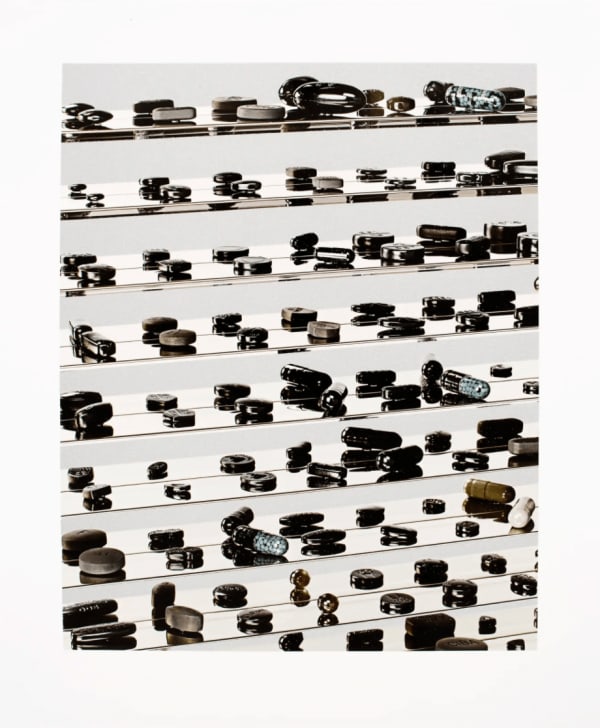Why Collect Damien Hirst?
Few artists have managed to merge spectacle, controversy, and commercial success quite like Damien Hirst. Whether he’s suspending sharks in formaldehyde, encrusting skulls with diamonds, or churning out spot paintings by the hundred, Hirst’s work remains as divisive as it is collectible.
For new collectors, Hirst offers a compelling mix of high-profile status and an ever-evolving market. His works can be found in the world’s top institutions, yet he also produces limited editions and prints that make his art accessible to a broader audience. If you’re looking to invest in contemporary art with both shock value and market credibility, Hirst is a name that should be on your radar.

Most Sought-After Works
Hirst’s market is vast and varied, with certain works commanding significantly more attention (and money) than others. His highest-selling works at galleries and the broader market include:
-
Lullaby Spring (2002) – A medicine cabinet filled with hand-painted pills, which sold for $19.2 million in 2007.
-
The Golden Calf (2008) – A preserved calf with 18-carat gold horns and hooves, sold for $18.6 million.
-
The Kingdom (2008) – A tiger shark suspended in formaldehyde, fetching $15.3 million.
-
Away from the Flock (1994) – A suspended lamb in formaldehyde, which sold for $4.1 million.
Among collector favorites are his Spot Paintings, which exist in many forms, with larger or hand-painted ones fetching the highest prices. His Spin Paintings, created by spinning canvases while pouring paint, are colorful, chaotic, and popular. His Butterfly Works, made using real butterfly wings, and Pill Cabinets & Medicine Cabinets, which feature pharmaceutical themes, are also highly valued.
Prints, Editions, and NFTs
While Hirst’s prints can be a great entry point for new collectors, some editions are highly diluted in value. Similarly, his venture into NFTs & Digital Works, particularly The Currency NFT project, was a bold experiment, but its long-term value remains uncertain.
Authentication: Avoiding Fakes
Authentication is crucial when purchasing a Hirst work. Certificates of authenticity (COA) should come from HENI, his official partner for prints and digital works, or Science Ltd., Hirst’s own studio handling authentication for older works. Limited editions should have clearly numbered signatures, while paintings and sculptures often feature gallery stamps or official labels. Given Hirst’s popularity, forgeries do exist, so it is best to avoid unsigned works or those without a traceable history.
Where to Buy Damien Hirst's Art
When considering where to buy Hirst’s work, collectors should turn to reputable galleries. Guy Hepner has historically sold his work, providing guaranteed authenticity and provenance. These galleries offer expert guidance on selecting works with strong investment potential and ensure that collectors are purchasing directly from a trusted source. Guy Hepner, in particular, has built a strong reputation for offering exclusive contemporary artworks, including Hirst’s most sought-after pieces.

Price Ranges for Hirst’s Work
Pricing for Hirst’s work varies significantly:
-
Prints and editions: $5,000 to $50,000, depending on size and edition number.
-
Spin and Spot Paintings: $50,000 to $500,000 or more for larger, rarer pieces.
-
Sculptures and major works: Upwards of $1 million.
-
Record sale: Lullaby Spring, a medicine cabinet, sold for $19.2 million in 2007.
Caring for Your Hirst Collection
Owning a Hirst piece isn’t just about displaying it; proper care is essential to maintaining its value:
-
Butterfly and Spin Paintings: Should be protected from prolonged exposure to sunlight and framed using museum-grade glass to prevent UV damage.
-
Prints and works on paper: Should be framed with archival materials to avoid yellowing and stored in a temperature-controlled room away from humidity.
Is Hirst a Good Investment?
As an investment, Hirst remains one of the most recognizable names in contemporary art, with a market that has shown resilience despite fluctuations. Institutional support from prestigious museums like Tate and MoMA bolsters his legacy. However, some of his editions and prints are overproduced, leading to value dilution. His market is also prone to hype cycles, with dramatic peaks and dips, meaning not every work is a wise investment. New collectors should be mindful of choosing pieces that are both high-quality and historically significant.
Final Thoughts
If you’re drawn to Hirst’s blend of spectacle, morbidity, and conceptual play, collecting his work can be both thrilling and rewarding. However, it is important to focus on authenticated, high-quality pieces rather than mass-produced editions. By doing your research, working with reputable galleries, and considering long-term value, you can build a collection that captures both the essence of Hirst’s art and its potential financial upside.
For more information on our Damien Hirst prints for sale please inquire online or get in touch with us at info@guyhepner.com. Looking to sell? We can help. Find out how to sell Damien Hirst art with Guy Hepner. Explore more Damien Hirst content in Damien Hirst butterflies, Damien Hirst skulls and Damien Hirst dots.





















